How to spot phishing emails like the fake email from Standard Bank
Phishing/ScamAlso Known As: Standard Bank phishing email
Get free scan and check if your device is infected.
Remove it nowTo use full-featured product, you have to purchase a license for Combo Cleaner. Seven days free trial available. Combo Cleaner is owned and operated by RCS LT, the parent company of PCRisk.com.
What kind of email is a fake letter from Standard Bank?
Our team has analyzed this email and found that it is written by scammers pretending to be representatives of Standard Bank. The purpose of this scam email is to trick recipients into entering personal information on the opened fake web page. Emails of this kind are called phishing emails. They should be marked as spam and deleted.
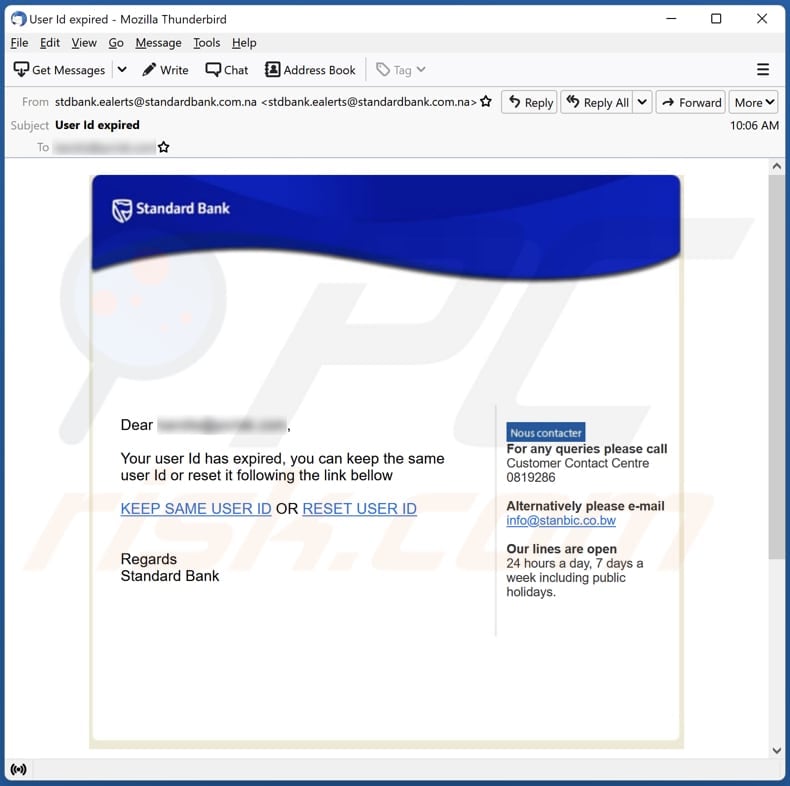
More about the Standard Bank phishing email
This phishing email claims that your user ID has expired and offers to keep the same user ID or reset it via the provided links. It includes "KEEP SAME USER ID" and "RESET USER ID" hyperlinks. Also, it contains a Standard Bank logo and contact information. Clicking any of the provided hyperlinks opens a fake Standard Bank page.
That fake website requests to sign in to an online banking account with a user ID and password. Thus, it is clear that scammers use it to steal login information. Stolen login credentials usually are misused for malicious purposes (e.g., to steal money, purchase goods, steal identities) or sold to third parties.
Thus, it is strongly recommended not to provide personal information on suspicious pages. Especially when they are opened via suspicious emails.
| Name | Standard Bank Email Scam |
| Threat Type | Phishing, Scam, Social Engineering, Fraud |
| Fake Claim | User ID has expired |
| Disguise | Letter from Standard Bank |
| Related Domain | abeeimport[.]com, balgowlahphysie[.]com |
| Detection Names (abeeimport[.]com) | Avira (Phishing), Combo Cleaner (Phishing), G-Data (Phishing), Kaspersky (Phishing), Netcraft (Malicious), Full List Of Detections (VirusTotal) |
| Symptoms | Unauthorized online purchases, changed online account passwords, identity theft, illegal access of the computer. |
| Distribution methods | Deceptive emails, rogue online pop-up ads, search engine poisoning techniques, misspelled domains. |
| Damage | Loss of sensitive private information, monetary loss, identity theft. |
| Malware Removal (Windows) |
To eliminate possible malware infections, scan your computer with legitimate antivirus software. Our security researchers recommend using Combo Cleaner. Download Combo CleanerTo use full-featured product, you have to purchase a license for Combo Cleaner. 7 days free trial available. Combo Cleaner is owned and operated by RCS LT, the parent company of PCRisk.com. |
Similar scam emails in general
The most common similarities between phishing emails are that they are disguised as important/official/urgent letters from legitimate companies, organizations, or other entities. Crooks use these emails to extract sensitive information (e.g., credit card details, passwords, ID card information, social security numbers, etc.).
Examples of different phishing emails are "Just Finished Sending 300 E-mails Scam", "Netflix - We've Suspended Your Membership Email Scam", and "NATURALISTS Email Scam". It is important to know that emails can also be used to deliver malicious software.
How do spam campaigns infect computers?
Cybercriminals behind emails used to deliver malware achieve their goal when users download and execute malware by themselves. They aim to trick recipients into opening malicious links or attachments.
Typically, users infect computers by enabling macros commands in opened malicious MS Office documents, opening executable files or files extracted from archives like ZIP and RAR, or executing JavaScript files. ISO files, PDF documents, and other files are also used to distribute malware.
How to avoid installation of malware?
Do not click links or open files received via email without double-checking emails. Links or attachments in irrelevant emails sent from unknown/suspicious addresses tend to be malicious. Keep the operating system and installed software updated. Do not trust advertisements on questionable websites.
Download software from reliable sources (official websites and verified stores) only. If you've already opened malicious attachments, we recommend running a scan with Combo Cleaner Antivirus for Windows to automatically eliminate infiltrated malware.
Text presented in the Standard Bank phishing letter:
Subject: User Id expired
Dear -,Your user Id has expired, you can keep the same user Id or reset it following the link bellow
KEEP SAME USER ID OR RESET USER ID
Regards
Standard Bank
Contact Us
For any queries please call Customer Contact Centre
0819286Alternatively please e-mail
info@stanbic.co.bwOur lines are open
24 hours a day, 7 days a week including public holidays.
Fake Standard Bank website:
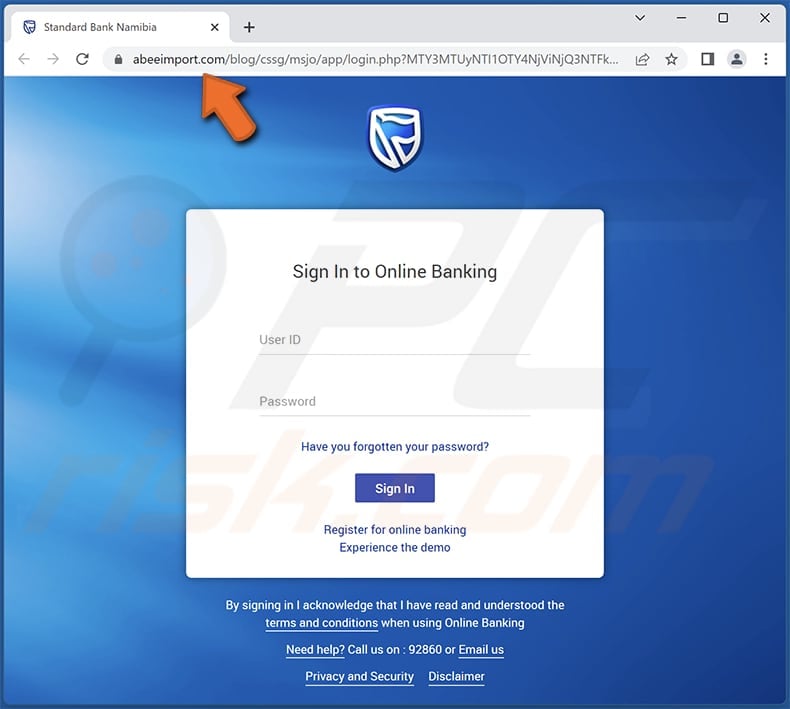
Another example of Standard Bank-themed spam email promoting an identical phishing site:
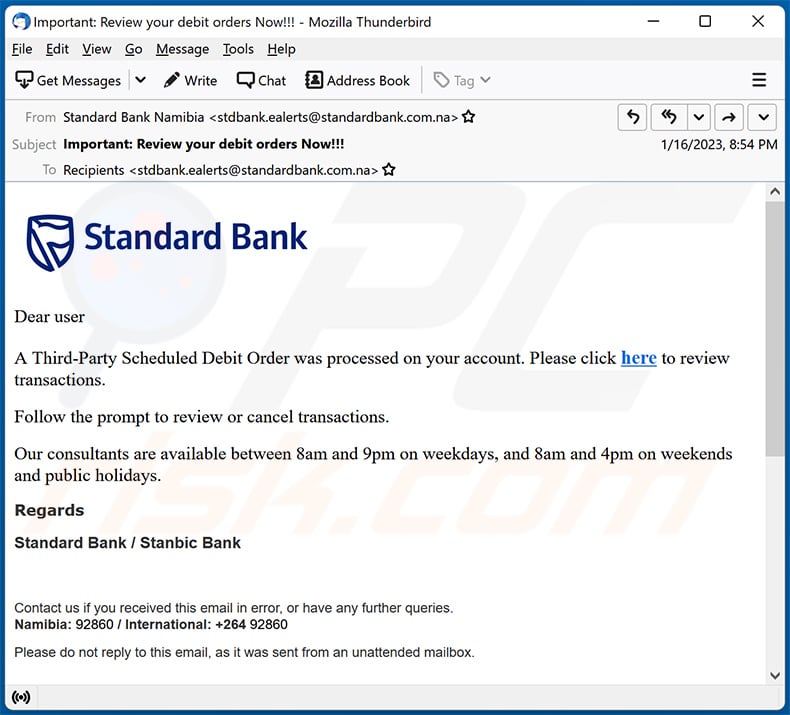
Text presented within:
Subject: Important: Review your debit orders Now!!!
Standard Bank
Dear user
A Third-Party Scheduled Debit Order was processed on your account. Please click here to review transactions.
Follow the prompt to review or cancel transactions.
Our consultants are available between 8am and 9pm on weekdays, and 8am and 4pm on weekends and public holidays.
Regards
Standard Bank / Stanbic BankContact us if you received this email in error, or have any further queries.
Namibia: 92860 / International: +264 92860
Another example of Standard Bank-themed spam email:
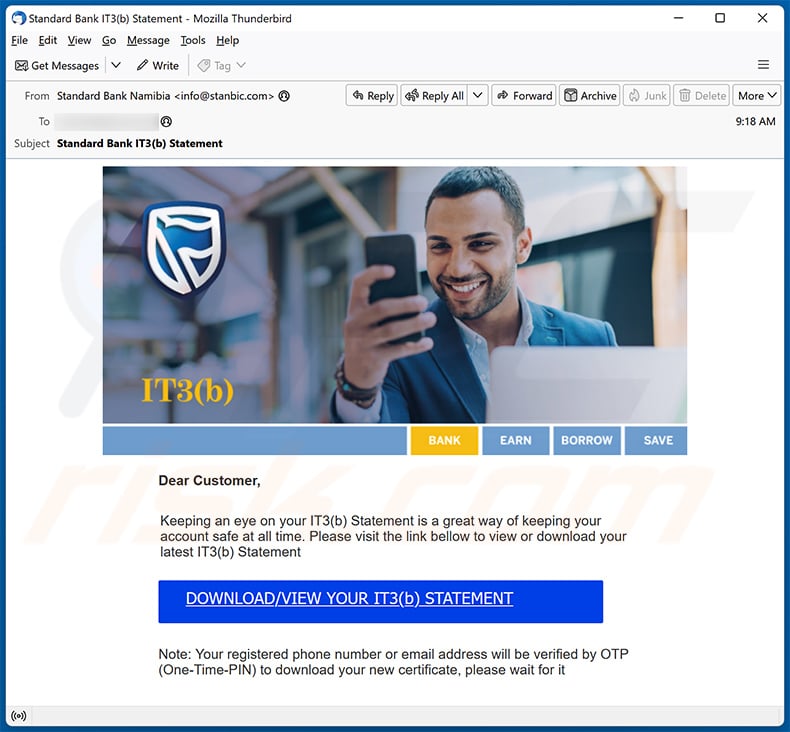
Text presented within:
Subject: Standard Bank IT3(b) Statement
Dear Customer,
Keeping an eye on your IT3(b) Statement is a great way of keeping your account safe at all time. Please visit the link bellow to view or download your latest IT3(b) Statement
DOWNLOAD/VIEW YOUR IT3(b) STATEMENT
Note: Your registered phone number or email address will be verified by OTP (One-Time-PIN) to download your new certificate, please wait for it
How to open the tax certificateTo open the certificate, you need to have Adobe PDF reader installed.
No PDF reader?
You can install the Adobe PDF Reader by doing the following:
Copy and paste this URL into your browser:
-
Go to the website
Click the download button and follow the easy instructionsKeeping your money and personal information secure is our priority. If you are concerned about any suspicious activity on your accounts, please call Fraud Line immediately on: 0800 222 050.
Yet another example of an email from "Standard Bank" spam campaign:
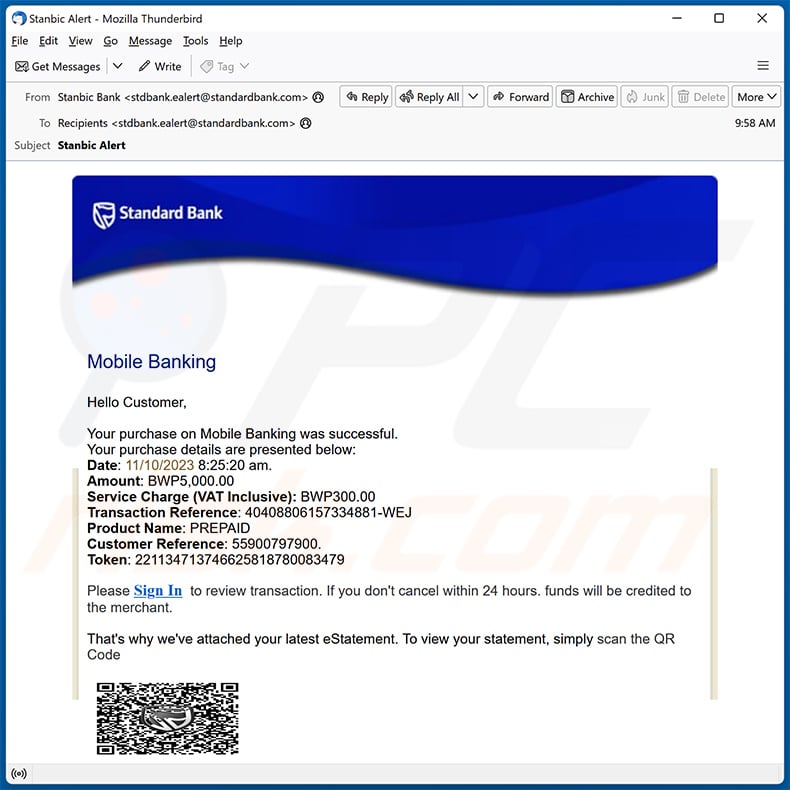
Text presented within:
Subject: Stanbic Alert
Standard Bank
Hello Customer,Your purchase on Mobile Banking was successful.
Your purchase details are presented below:
Date: 11/10/2023 8:25:20 am.
Amount: BWP5,000.00
Service Charge (VAT Inclusive): BWP300.00
Transaction Reference: 40408806157334881-WEJ
Product Name: PREPAID
Customer Reference: 55900797900.
Token: 221134713746625818780083479Please Sign In to review transaction. If you don't cancel within 24 hours. funds will be credited to the merchant.
That's why we've attached your latest eStatement. To view your statement, simply scan the QR Code
Another example of an email from "Standard Bank" spam campaign:
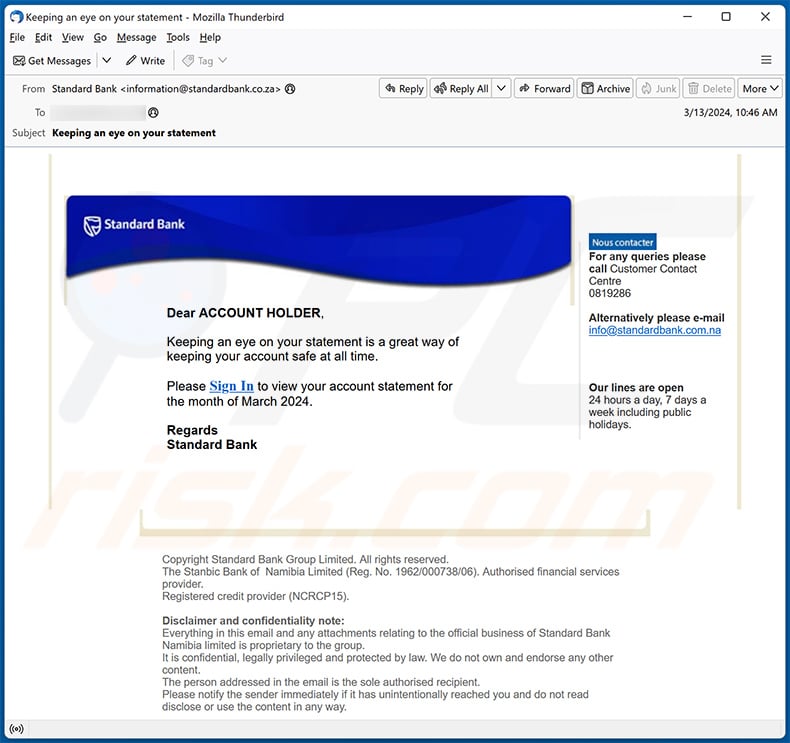
Text presented within:
Subject: Keeping an eye on your statement
Standard Bank
Dear ACCOUNT HOLDER,
Keeping an eye on your statement is a great way of keeping your account safe at all time.
Please Sign In to view your account statement for the month of March 2024.
Regards
Standard Bank
Contact UsFor any queries please call Customer Contact Centre
0819286Alternatively please e-mail
info@standardbank.com.naOur lines are open
24 hours a day, 7 days a week including public holidays.
Instant automatic malware removal:
Manual threat removal might be a lengthy and complicated process that requires advanced IT skills. Combo Cleaner is a professional automatic malware removal tool that is recommended to get rid of malware. Download it by clicking the button below:
DOWNLOAD Combo CleanerBy downloading any software listed on this website you agree to our Privacy Policy and Terms of Use. To use full-featured product, you have to purchase a license for Combo Cleaner. 7 days free trial available. Combo Cleaner is owned and operated by RCS LT, the parent company of PCRisk.com.
Quick menu:
- What is Standard Bank phishing email?
- Types of malicious emails.
- How to spot a malicious email?
- What to do if you fell for an email scam?
Types of malicious emails:
![]() Phishing Emails
Phishing Emails
Most commonly, cybercriminals use deceptive emails to trick Internet users into giving away their sensitive private information, for example, login information for various online services, email accounts, or online banking information.
Such attacks are called phishing. In a phishing attack, cybercriminals usually send an email message with some popular service logo (for example, Microsoft, DHL, Amazon, Netflix), create urgency (wrong shipping address, expired password, etc.), and place a link which they hope their potential victims will click on.
After clicking the link presented in such email message, victims are redirected to a fake website that looks identical or extremely similar to the original one. Victims are then asked to enter their password, credit card details, or some other information that gets stolen by cybercriminals.
![]() Emails with Malicious Attachments
Emails with Malicious Attachments
Another popular attack vector is email spam with malicious attachments that infect users' computers with malware. Malicious attachments usually carry trojans that are capable of stealing passwords, banking information, and other sensitive information.
In such attacks, cybercriminals' main goal is to trick their potential victims into opening an infected email attachment. To achieve this goal, email messages usually talk about recently received invoices, faxes, or voice messages.
If a potential victim falls for the lure and opens the attachment, their computers get infected, and cybercriminals can collect a lot of sensitive information.
While it's a more complicated method to steal personal information (spam filters and antivirus programs usually detect such attempts), if successful, cybercriminals can get a much wider array of data and can collect information for a long period of time.
![]() Sextortion Emails
Sextortion Emails
This is a type of phishing. In this case, users receive an email claiming that a cybercriminal could access the webcam of the potential victim and has a video recording of one's masturbation.
To get rid of the video, victims are asked to pay a ransom (usually using Bitcoin or another cryptocurrency). Nevertheless, all of these claims are false - users who receive such emails should ignore and delete them.
How to spot a malicious email?
While cyber criminals try to make their lure emails look trustworthy, here are some things that you should look for when trying to spot a phishing email:
- Check the sender's ("from") email address: Hover your mouse over the "from" address and check if it's legitimate. For example, if you received an email from Microsoft, be sure to check if the email address is @microsoft.com and not something suspicious like @m1crosoft.com, @microsfot.com, @account-security-noreply.com, etc.
- Check for generic greetings: If the greeting in the email is "Dear user", "Dear @youremail.com", "Dear valued customer", this should raise suspiciousness. Most commonly, companies call you by your name. Lack of this information could signal a phishing attempt.
- Check the links in the email: Hover your mouse over the link presented in the email, if the link that appears seems suspicious, don't click it. For example, if you received an email from Microsoft and the link in the email shows that it will go to firebasestorage.googleapis.com/v0... you shouldn't trust it. It's best not to click any links in the emails but to visit the company website that sent you the email in the first place.
- Don't blindly trust email attachments: Most commonly, legitimate companies will ask you to log in to their website and to view any documents there; if you received an email with an attachment, it's a good idea to scan it with an antivirus application. Infected email attachments are a common attack vector used by cybercriminals.
To minimise the risk of opening phishing and malicious emails we recommend using Combo Cleaner Antivirus for Windows.
Example of a spam email:

What to do if you fell for an email scam?
- If you clicked on a link in a phishing email and entered your password - be sure to change your password as soon as possible. Usually, cybercriminals collect stolen credentials and then sell them to other groups that use them for malicious purposes. If you change your password in a timely manner, there's a chance that criminals won't have enough time to do any damage.
- If you entered your credit card information - contact your bank as soon as possible and explain the situation. There's a good chance that you will need to cancel your compromised credit card and get a new one.
- If you see any signs of identity theft - you should immediately contact the Federal Trade Commission. This institution will collect information about your situation and create a personal recovery plan.
- If you opened a malicious attachment - your computer is probably infected, you should scan it with a reputable antivirus application. For this purpose, we recommend using Combo Cleaner Antivirus for Windows.
- Help other Internet users - report phishing emails to Anti-Phishing Working Group, FBI’s Internet Crime Complaint Center, National Fraud Information Center and U.S. Department of Justice.
Frequently Asked Questions (FAQ)
Why did I receive this email?
All recipients received the same letter. This email is non-targeted. Even those who are not customers of Standard Bank received this letter.
I have provided my personal information when tricked by this email, what should I do?
If you are a client of Standard Bank and have provided your user ID and password on a phishing page, contact the bank as soon as possible. If the provided password can be used to access not just the online banking account, change other passwords too.
I have downloaded and opened a malicious file attached to an email, is my computer infected?
Usually, executables infect computers after they are opened/executed. Microsoft Office documents infect computers after enabling macros commands. Other files (e.g., archives like ZIP and RAR, PDF documents) cannot cause harm until they are opened, and additional steps are performed. Thus, it depends on the type of file that was opened.
I have read the email but didn't open the attachment, is my computer infected?
No, emails are harmless until their contents are opened.
Will Combo Cleaner remove malware infections that were present in email attachment?
Combo Cleaner will remove malware from the operating system (it can detect almost all known malware). It is strongly recommended to run a full system scan to remove high-end malware. Typically, malware of this kind hides deep in the system (running a quick scan is usually not enough to detect and remove it).
Share:

Tomas Meskauskas
Expert security researcher, professional malware analyst
I am passionate about computer security and technology. I have an experience of over 10 years working in various companies related to computer technical issue solving and Internet security. I have been working as an author and editor for pcrisk.com since 2010. Follow me on Twitter and LinkedIn to stay informed about the latest online security threats.
PCrisk security portal is brought by a company RCS LT.
Joined forces of security researchers help educate computer users about the latest online security threats. More information about the company RCS LT.
Our malware removal guides are free. However, if you want to support us you can send us a donation.
DonatePCrisk security portal is brought by a company RCS LT.
Joined forces of security researchers help educate computer users about the latest online security threats. More information about the company RCS LT.
Our malware removal guides are free. However, if you want to support us you can send us a donation.
Donate
▼ Show Discussion